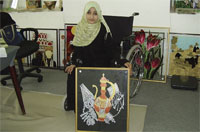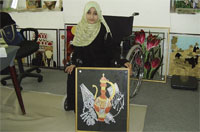
Breaking the glass ceiling through painting on glass [Archives:2007/1060/Reportage]
June 18 2007
 |
 |
“I can be a businesswoman,” says Manal Lutfi, one of the distinctive students in the glass painting enterprise.
“After I finished the enterprise, which lasted a month, the institute called me to work as a trainer assistant.” Because Lutfi only completed high school, this course means a lot to her and she now feels that she's more capable to begin a project of her own and succeed at it. “Even though I don't have drawing skills, I excelled in glass painting because the most important skills needed are patience and accuracy,” she added.
Bushra Abdullah, executive director of the Impact Institute for Women's Development, explains, “We named our institute impact in order to have a realistic impact on women's lives.”
She and Iman Hassan, the business partner, insisted on establishing the institute and “digging in the rocks,” as Abdullah describes it, not only to give women a chance to acquire a skill, but also to create new small business opportunities.
Very few institutes in Yemen train in the art of glass. This type of art is more lucid in Yemen, as seen in the qamariyya, but nowadays, it takes other forms. “We create new ideas; for example, we use this type of art with vases and alabaster,” glass painting trainer Maisun Hussein says.
Samya Mohammed, one trainee in the diploma scholarship program for women in glass painting, affirms a big difference in her life. “Since I'm disabled, I feared facing society and their perspectives about me. Because I can't walk, I didn't go to school; however, I enrolled in the Challenge Center at age 12 and began studying. I then received the chance for this diploma to prove to everyone that the disabled can make a difference in their society and that they aren't parasites upon their families, as many in society believe.”
After completing the diploma, Mohammed plans to realize her dream and establish a fashion show. “I'm now thinking about the steps I need to accomplish my project.”
The diploma scholarship is for several months, wherein women have the opportunity to train in glass painting, as well as administrative skills, including management, marketing, accounting principles and preparing a business plan.
Hussein comments, “Trainees must be accurate, patient and clean. They need not be artists because there's a picture under the glass, on which they then illustrate it.”
She continued, “At the beginning of the course, we give trainees small piece of glass, on which they first learn to draw the outline of the picture and then they learn to fill the space with color. Each trainee receives six pieces of glass and the sixth evaluates her level.”
Although trainee Mirvat Mohammed Jabir is a chemistry graduate, this scholarship not only provides her the opportunity to learn glass painting skills, she also can put them into action.
After trainees attempt to market their works, they sit together for each one to describe the obstacles she faced. “On this day, we bring in a woman with a particular skill who used it and made a difference in her life,” Abdullah explained. According to her, meeting someone who began at zero and, due to a strong desire, she became a businesswoman, makes the trainees more confident about themselves.
Founded by the Dutch Embassy, the project seeks to provide 20 low-income women and girls the opportunity to be trained within three months on how to make their own products, such as colored vases, painted pictures and other traditional paintings. The project also offers administrative, financial and marketing training in order to help the women become entrepreneurs and start their own businesses.
Abdullah notes that the diploma trainees are those women with low incomes and the program aims to increase the number of businesswomen in Yemen and help them become independent.Traditionally, glass painting refers to painting on the surface of a sheet of glass to be included in a stained glass work. This type of painting, which actually is closer to drawing, was done to add details such as faces and folds of clothing, which couldn't be added with traditional lead lines. It also was used to cover up portions of stained glass work so that light was kept from shining through.
According to Hussein, the origin of art glass emerged in the church, but according to www.thestorefinder.com, the origins of the first stained glass are lost in history. The technique probably came about from jewelry making, cloisonne and mosaics.Stained glass seemed to arise when substantial church building began. By the 10th century, depictions of Christ and biblical scenes were found in French and German churches and decorative designs found in England.
Glass is most like a super-cooled liquid. It captures light and glows from within. It is a jewel-like substance made from the most ordinary materials: sand transformed by fire.
Before recorded history, man learned to make glass and color it by adding metallic salts and oxides. These minerals within the glass capture specific portions from the spectrum of white light allowing the human eye to see various colors. Gold produces stunning cranberry, cobalt makes blues and silver creates yellows and golds, while copper makes greens and brick red.
Stained glass, or more appropriately, art glass, is all around us today. An explosion of interest in the past 30 years has given rise to many new and imaginative forms of this art. The rise of the individual artist, new technologies and the growing interest in stained glass as a hobby craft all have led to what's being called a new golden age in glass.
Decorative panels are purchased simply to hang in a sunny window. Marvelous hot formed glass pieces adorn tables, walls, shelves and fill windows. New artists are combining, creating and developing unique new forms and styles every day.
——
[archive-e:1060-v:15-y:2007-d:2007-06-18-p:report]


